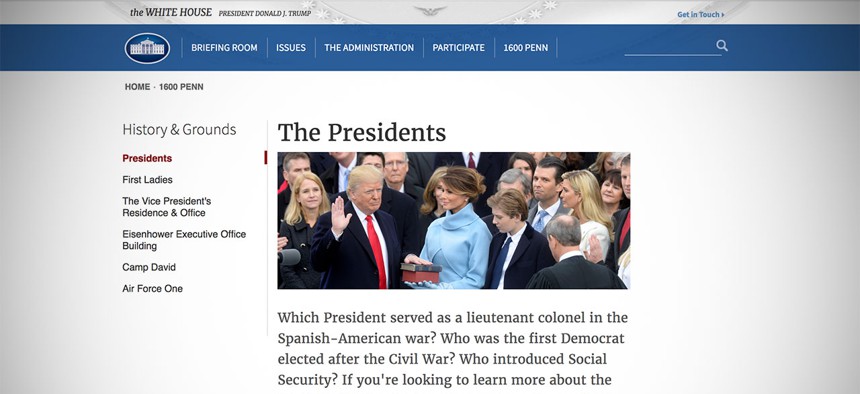Our interactions with government websites are often memorable for all the wrong reasons. Whether you’re trying to change your official address or applying for a local permit, you’re likely to see conflicting information, have to pinch-and-zoom a non-responsive design, or need a law degree to understand the five-paragraph disclaimer below a simple log-in form.
In a world where industry giants like Facebook run hundreds of user experience tests daily, why are our government websites so far behind the curve? I witnessed this problem first hand at the US Department of State and while running the White Houses’s digital technology initiatives under Obama. And I discovered that while change does not exactly happen overnight in these large bureaucracies, it is possible. And we, as frustrated citizens, should be demanding it.
The Trump administration is focused on upgrading a crumbling public infrastructure, proposing to invest $1 trillion over 10 years. Though not crumbling, our government’s digital infrastructure is weak and inferior. The systems through which we receive government services should be deemed as critical as our roads and bridges.
We must remember that our government is here to serve the people. Military jets should not fall out of the sky, filing taxes should not fail, and you should get your social-security benefits on time. Using internet services quickly and easily should be no different. Government websites exist to provide citizens with essential services and information, yet more often than not, it is difficult to find voter registration information or the form to pay your parking ticket.
As citizens, it can be hard to understand why our local governments are so slow to innovate. In my experience, I found that it has less to do with technical ability and skill and more to do with an environment of complacency. Innovation requires risk, and that’s a potential headache most governments want to avoid.
In contrast to agile, private-sector companies, the public sector does not face any pressure from competition. When it comes time to renew your license, there is only one place for you to do that: and, unfortunately for Americans, that’s the DMV. With no competitive forces, government agencies do not have to innovate or take bold risks when it comes to digital.
It is our right—and responsibility—to hold our government accountable. In today’s digital-first world, that means expecting government websites to be easy-to-use, accessible to all, up-to-date, and intuitive. From finding health insurance options to scheduling a road test, if someone cannot easily access information, the government is failing its constituency.
Understanding the best technology for the job is a smart first step toward change. Over the last few years, I have worked with public-sector digital teams to invest in open-source technology solutions. While running technology for Obama’s WhiteHouse.gov, open-source solutions enabled our team to deliver projects on budget and up to 75% faster than alternative proprietary-software options. More than anything, open-source technology allows governments to utilize a large ecosystem of developers, which enhances innovation and collaboration while driving down the cost to taxpayers.
Unfortunately, not every leader in the public sector understands what is at stake. Transforming outdated government websites needs far more than legislation to spur innovation: They’ll require market pressure to push governments to improve service delivery. This pressure should come from a groundswell of demands voiced by citizens like you and me. We should not allow ourselves to fall into complacency of crappy government portals, accepting the status quo as immutable. Government can and will change if, collectively, we demand more.
Change is possible, and for some governments, it is already underway. In Arkansas, for example, government leaders sought a better way to become citizen-centric. Consequently, they became the first state to launch a digital government assistant, Gov2Go. The assistant allows Arkansans to receive personalized notifications from the state and keep track of important deadlines such as voter registration, property-tax payments, vehicle-registration renewals, and more. The State of New York, the province of Ontario, and the City of Boston are other governments listening to the demands of their constituents.
In our time-pressed society, we’re unlikely to waste hours (or even three minutes) on websites that lack the information we seek. If this rule applies in our professional and personal lives, it should absolutely be true for our interactions with the government. Now, more than ever before, digital leaders working in government, on both a local and national scale, need to challenge the status quo and embrace the shift toward citizen-first digital experiences. At the same time, citizens need to recognize when their government is not providing them with adequate access to crucial resources and services—and make the choice to do something about it.
You can be part of transforming the government experience by demanding more. You are funding these agencies with your tax money; you have the right and the responsibility to push for better service delivery. Become civically engaged and contact your elected leaders today. Tell them to look at standout examples of the public sector focusing on a citizen-first digital transformation.
When the City of Boston embarked on its digital transformation, one of the team’s guiding principles was for the new site to “act as a helpful human.” Choosing to bring public-sector websites into today’s digital-first age is choosing to humanize government and, ultimately, better serve its citizens. This is the perspective of the future—one that all public-sector leaders should aspire to and all citizens should demand.



